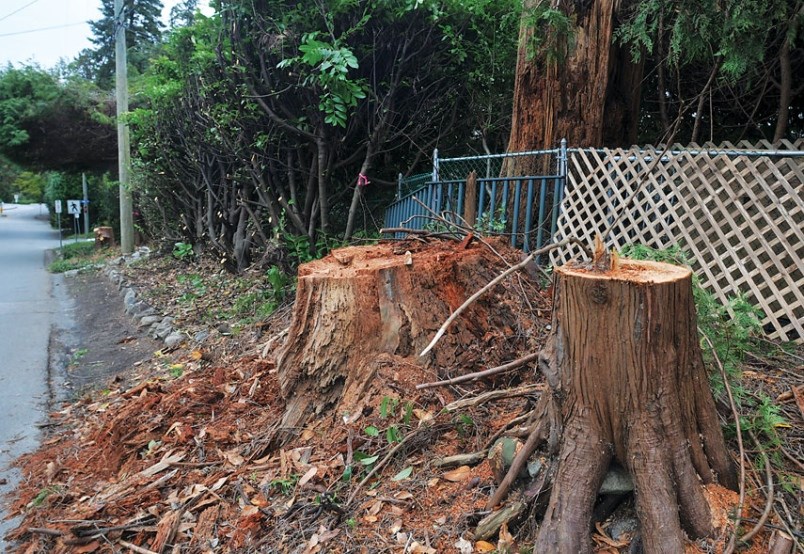West Vancouver’s bylaw protecting trees on private property could soon carry more bark and more bite.
Council voted Monday night for a new, stricter set of rules property owners must follow if they want to fire up the chainsaw.
After months of complaints from residents about entire lots being clear-cut to make room for development of massive homes, West Vancouver passed an interim tree bylaw protecting trees with a diameter of 75 centimeters or more in 2016. But that proved highly divisive in the community, where some saw it as an intrusion on their property rights, shutting out sunlight from yards and blocking ocean views.
Council struck a working group, which spent 15 months consulting and studying options, ultimately coming up with a proposal for a minimum number of trees on residential lots, mandatory self-reporting for tree removal, a cash-in-lieu option when the minimum number of trees could not be met and maximum hedge heights.
On Monday night, district staff warned many of those strategies would be too difficult enforce and do little to stop the clear cuts. Staff recommended their own motion for council to vote on, which would essentially have kept the interim tree bylaw as it is, but with some tighter regulations.
Council ended up, however, adopting neither staff nor the working group’s recommendations and instead directed staff to begin drawing up a new bylaw proposed at the council table by Coun. Craig Cameron.
Cameron’s motion gives protection to trees with a 35-centimetre diameter. Under the proposed bylaw, residents will be allowed to remove, with a permit, one tree over the 35-centimetre threshold once every three years on properties in Ambleside and Dundarave and one per year on properties elsewhere in the district. For every tree removed from a residential property, another one must be planted.
Cameron said his motion was intended to strike the right balance between protecting West Vancouver’s tree canopy but also allowing homeowners to reasonably manage their property.
“When we set the 75-centimetre [minimum diameter for protected trees] three years ago, we never considered it to be sufficient or something that should be maintained, and we realized that it only covered the biggest trees,” he said.
Dozens of residents turned out to sound off against the bylaw, most of them asking council to make it more restrictive, arguing that it was necessary to combat climate change, maintain the integrity of the sloped landscape and offer natural health benefits to residents.
Mayor Mary-Ann Booth showed some reticence at going from one interim policy with an arbitrary protected tree size to another interim policy with another arbitrary protected tree size, but supported the motion.
“The main issue that brought us here was the losing of mature trees on development lots and I do feel like we’re kind of punishing the whole classroom for the ill of maybe only one student, proportionately. Most residents were doing the right thing and it was unfortunate we had this hysterical housing frenzy that caused money to drive every decision that was made around lot development,” she said.
Support wasn’t unanimous, however. Coun. Nora Gambioli said she couldn’t justify picking a new minimum diameter for protected trees that wasn’t informed by any scientific reasoning.
And Couns. Sharon Thompson and Marcus Wong both said the new rules created too many uncertainties.
The new bylaw will still require three readings by council before it comes into effect but even then, it’s likely bound to change again. As part of the motion, the district will spend the next six months developing a study of its existing tree canopy using LIDAR, which will be used to inform a later Urban Forest Management Plan.



